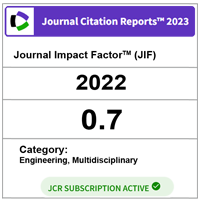PROPERTIES AND PERFORMANCE OF WATER TREATMENT SLUDGE (WTS)-CLAY BRICKS
DOI:
https://doi.org/10.11113/jt.v77.6989Keywords:
Water treatment sludge, clay brick, recycling waste, brick makingAbstract
Every year, large quantity of water treatment sludge (WTS) is produced from water treatment plant in Malaysia. Sanitary landfill disposal of sludge at authorized sites is the common practice in Malaysia. However, searching the suitable site for landfill is the major problem as the amount of sludge produced keeps on increasing. Reuse of the sludge could be an alternative to disposal. This study investigated the reusability of WTS as brick making material. The performance of clay-WTS bricks produced by mixing clay with different percentages of WTS with increments of 20% from 0% up to 100% was investigated. Each molded brick with optimum moisture content was pressed under constant pressure, oven-dried at 100˚C for 24 hours followed by heating at 600˚C for 2 hours and 1000˚C for 3 hours. Scanning electron microscopy (SEM), X-ray diffraction (XRD) and energy dispersive X-ray (EDX) analysis were used to characterize clay, WTS and clay-WTS bricks. The performance of the bricks were evaluated with firing shrinkage, loss on ignition (LOI), water absorption, bulk density, and compressive strength tests. Increasing the sludge content results in a decrease of brick firing shrinkage, and increase of water absorption and compressive strength. The results revealed that the brick with 100% by weight of sludge could generate the highest compressive strength of 17.123N/mm2. It can be concluded that the bricks with 20 to 100% of water treatment sludge comply with the Malaysian Standard MS7.6:1972, which can fulfill the general requirement for usage of clay bricks in wall construction.
References
Every year, large quantity of water treatment sludge (WTS) is produced from water treatment plant in Malaysia. Sanitary landfill disposal of sludge at authorized sites is the common practice in Malaysia. However, searching the suitable site for landfill is the major problem as the amount of sludge produced keeps on increasing. Reuse of the sludge could be an alternative to disposal. This study investigated the reusability of WTS as brick making material. The performance of clay-WTS bricks produced by mixing clay with different percentages of WTS with increments of 20% from 0% up to 100% was investigated. Each molded brick with optimum moisture content was pressed under constant pressure, oven-dried at 100ËšC for 24 hours followed by heating at 600ËšC for 2 hours and 1000ËšC for 3 hours. Scanning electron microscopy (SEM), X-ray diffraction (XRD) and energy dispersive X-ray (EDX) analysis were used to characterize clay, WTS and clay-WTS bricks. The performance of the bricks were evaluated with firing shrinkage, loss on ignition (LOI), water absorption, bulk density, and compressive strength tests. Increasing the sludge content results in a decrease of brick firing shrinkage, and increase of water absorption and compressive strength. The results revealed that the brick with 100% by weight of sludge could generate the highest compressive strength of 17.123N/mm2. It can be concluded that the bricks with 20 to 100% of water treatment sludge comply with the Malaysian Standard MS7.6:1972, which can fulfill the general requirement for usage of clay bricks in wall construction.
Downloads
Published
Issue
Section
License
Copyright of articles that appear in Jurnal Teknologi belongs exclusively to Penerbit Universiti Teknologi Malaysia (Penerbit UTM Press). This copyright covers the rights to reproduce the article, including reprints, electronic reproductions, or any other reproductions of similar nature.





